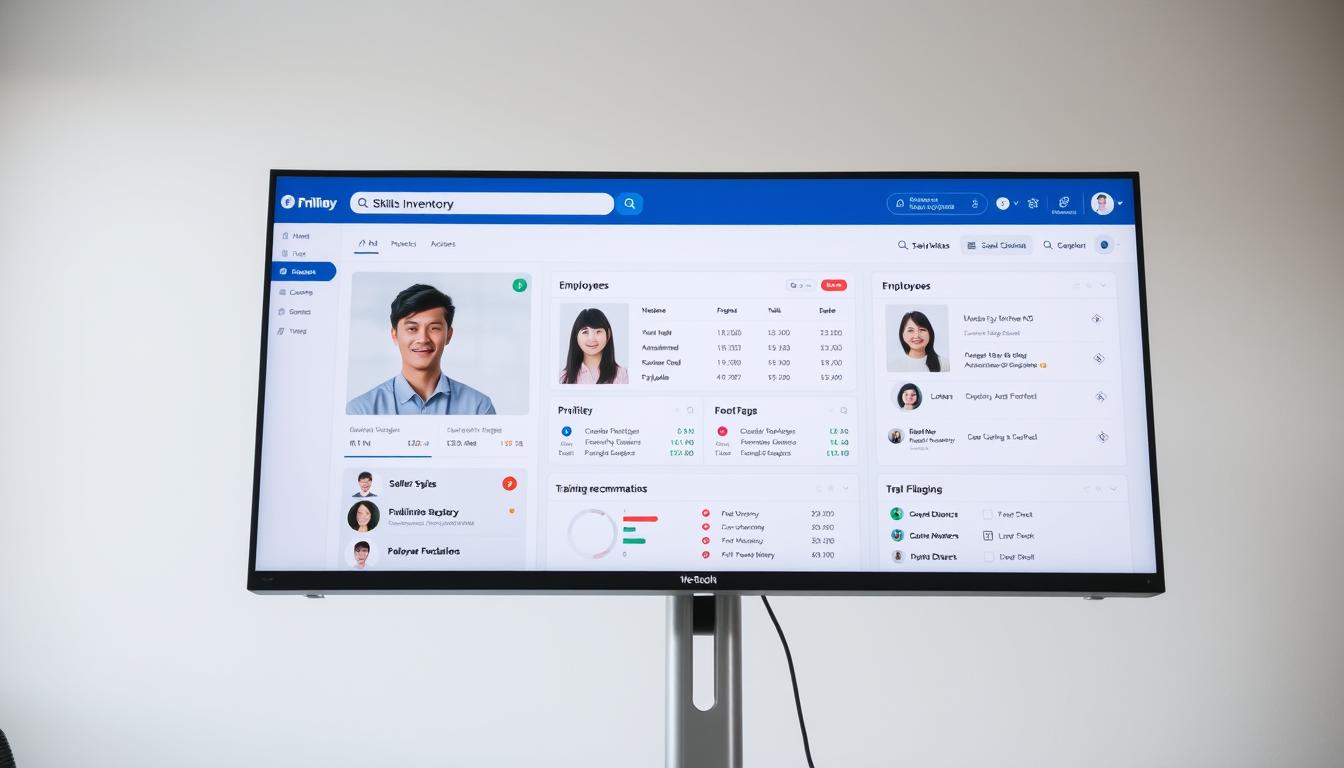Ever thought about how some businesses match employee skills with shift needs so smoothly? Others seem to struggle with scheduling. In fast-paced sectors like hospitality, retail, and healthcare, good scheduling is key. Using tech to auto-assign shifts based on skills boosts productivity and uses workforce tools wisely.
This guide is for SMEs in the Philippines. We’ll look into how auto-assigning shifts can improve resource use and worker engagement. Let’s see how to make your scheduling better with this new approach!
Key Takeaways
- Understanding the significance of auto-assign shifts in enhancing operational efficiency.
- Identifying workforce tools tailored for effective scheduling & shift management.
- Recognizing the importance of employee skills in optimizing shift assignments.
- Exploring the benefits that automation brings to workforce scheduling.
- Learning about best practices for implementing auto-assignment strategies.
Understanding the Need for Automated Shift Assignments
Managing shifts in small and medium enterprises (SMEs) in the Philippines is tough. The need for automated shift assignments is growing. Companies face challenges with staffing, leading to irregular schedules that stress employees.
Shift automation can change how businesses work. It helps avoid scheduling mistakes and boosts efficiency. This method is key for fair work distribution, making teams work better together. It also makes schedules predictable, which improves employee happiness and engagement.
Studies show that automated processes give big benefits. Companies using them see lower turnover and happier employees. This is crucial in competitive fields like retail and hospitality. Adopting shift automation makes operations smoother and creates a better work environment.
| Benefits of Automated Shift Assignments | Impact on Workforce |
|---|---|
| Reduction in scheduling errors | Enhances operational efficiency |
| Fair workload distribution | Increases employee morale |
| Predictable scheduling | Improves job satisfaction |
| Lower turnover rates | Boosts organizational stability |
What is Auto-Assigning Shifts?
Auto-assigning shifts is a new way to manage work teams. It uses smart software to match employees with the right shifts. This method aims to reduce the need for manual scheduling, cutting down on errors and boosting productivity.
In fields like hospitality and field service, scheduling automation is key. It helps supervisors match tasks with the right people. This ensures employees are both available and have the right skills for the job.
Here’s a table to show how auto-assigning shifts compare to old ways:
| Feature | Auto-Assigning Shifts | Traditional Scheduling |
|---|---|---|
| Time Efficiency | High | Low |
| Conflict Reduction | Very Low | High |
| Employee Satisfaction | Increased | Variable |
| Skill Alignment | Automatic | Manual |
Switching to auto-assigning shifts changes how companies handle their teams. It makes operations smoother and keeps employees happy.
The Role of Employee Skills in Shift Management
Employee skills are key to good shift management. They greatly affect how well a team works. By knowing what skills each employee has, managers can match them with the right tasks. This makes the team work better and more efficiently.
Using skill mapping helps teams adapt quickly. When employees know their strengths and weaknesses, they can get better. Cross-training also helps by teaching them new skills for different tasks. This is very important in places like retail, where many skills are needed to handle changing customer needs.
Good talent optimization is about placing the right people in the right spots. When managers can see what skills everyone has, they make better decisions. This leads to a happier team and better service.
| Skill Category | Importance in Shift Management | Impact on Talent Optimization |
|---|---|---|
| Customer Service | Essential for enhancing customer satisfaction | Improves retention and loyalty |
| Technical Skills | Helps in operating specialized equipment | Enables seamless operations |
| Problem-Solving | Facilitates quick resolutions to issues | Increases efficiency and morale |
| Communication | Ensures clear instructions and team cohesion | Promotes a collaborative environment |
Benefits of Automating Shift Assignments
Automating shift assignments brings many benefits to the workplace. One big advantage of shift automation is how it boosts operational efficiency. Companies can make their scheduling faster and less time-consuming. This means they can adjust to changes in employee availability better, keeping the team productive.
Automating shift assignments also cuts down on mistakes. Manual scheduling can lead to conflicts and misunderstandings. But automated systems help avoid these problems, making the workflow smoother. Plus, employees get to have more control over their schedules, leading to better work-life balance and job happiness.
Companies that use these systems can schedule more flexibly. This flexibility helps deal with absenteeism better, as employees are more likely to stay if their needs are met. Also, turnover rates go down as employees feel more at home in their work environment. Overall, the advantages of shift automation go beyond just scheduling. They help create a more adaptable and skilled workforce.
| Benefits | Impact on Business |
|---|---|
| Improved Operational Efficiency | Speeds up scheduling and workflow management. |
| Reduced Manual Errors | Decreases scheduling conflicts and miscommunications. |
| Enhanced Employee Engagement | Boosts job satisfaction through flexible scheduling. |
| Lower Absenteeism Rates | Encourages commitment and reduces no-shows. |
| Decreased Turnover Rates | Fosters loyalty and long-term employment. |
Key Features of Effective Shift Automation Tools
In today’s fast-paced world, features of shift automation tools are key for better effective workforce management. They make scheduling easier and improve talks between bosses and workers. This boosts productivity overall.
A user-friendly interface is a big plus. It makes it easy for everyone to use the system, cutting down on learning time. You can also customize it to fit your business needs.
Real-time data analytics are crucial for keeping an eye on how things are going. Managers can make smart choices fast. Plus, linking scheduling tools with chat platforms helps teams talk better and clearer.
In the Philippines, using these advanced tools can really help daily work in many fields. By matching tech with business goals, companies can make a better work place. This improves user experience and leads to success.
How to Implement a Skills Inventory System
Setting up a skills inventory system is key for businesses to better manage shifts. It gives a clear view of what each employee can do. This helps in smart scheduling and boosts team performance.
By mapping skills well, companies can match people with the right jobs. This makes work flow smoothly.
Importance of Skill Mapping for Efficient Scheduling
Skill mapping is crucial for good scheduling. It lets managers see who has what skills. This helps in giving the right tasks to the right people.
By mapping skills right, companies can:
- Make employees happier by giving them tasks they’re good at.
- Save time on training by using what they already know.
- Make sure important jobs are done by the right people, keeping things running smoothly.
Leveraging Digital Tools to Maintain Skill Records
Using digital tools to keep track of skills is essential today. These tools make it easy to update and access skill information. The benefits include:
- Streamlining data management: Keep track of and change employee skills easily.
- Providing insights: Get reports to help make smart scheduling choices.
- Facilitating adaptability: Adjust quickly to new needs or unexpected staff shortages.
Integrating Auto-Assigning Tools with Existing Systems
In today’s fast-paced business world, linking scheduling tools with current systems is key for good shift management. By connecting auto-assigning tools to HR networks, payroll systems, and workforce apps, businesses can run smoother. This connection cuts down on mistakes, saves time, and makes operations more efficient.
With digital changes happening fast in the Philippines, companies can get better at work through technology partnerships. For example, using SAP SuccessFactors or Oracle HCM Cloud for HR and strong scheduling software helps manage the workforce better. This teamwork makes decisions easier and helps meet the need for quick changes in managing the workforce.
Also, matching these tools helps businesses quickly adjust to staffing needs. Auto-assigning tools give clear views of who’s available and what skills they have. This makes shift assignments more effective. Companies that focus on this integration can manage resources smarter, helping employees balance work and life better while keeping productivity high.
| System Type | Benefits | Examples |
|---|---|---|
| HR Networks | Centralizes employee information for better management | SAP SuccessFactors, Workday |
| Payroll Systems | Automates payments and reduces administrative burden | QuickBooks, Gusto |
| Workforce Management Tools | Improves scheduling accuracy and response times | Deputy, When I Work |
To get the most from scheduling tool integration, businesses need to pick systems that work well together. They should support real-time updates and meet the company’s specific needs. This way, employees are happier, and managing the team becomes more dynamic.
Best Practices for Scheduling & Shift Management
Creating a good shift management plan means using scheduling best practices. These practices focus on being flexible and keeping employees happy. A plan that fits both the company’s needs and what employees want can really boost productivity and happiness.
Creating a Flexible Scheduling Framework
A flexible scheduling system helps meet the changing needs of workers while keeping things running smoothly. This can include:
- Offering many shift options for employees to pick from.
- Using rotating schedules to mix things up and avoid burnout.
- Using software to make scheduling easier.
By adding these features, companies can create a supportive environment. This leads to happier employees and better retention.
Adapting to Employee Preferences and Availability
It’s key to understand what employees want in a schedule. Important steps are:
- Doing regular surveys to hear about scheduling wishes.
- Keeping open lines of communication for employees to share their availability.
- Having a system that handles special requests without losing efficiency.
These actions help make a better schedule that everyone can live with. When employees feel heard, the whole workplace gets better.
| Flexible Scheduling Benefits | Impact on Employee Engagement |
|---|---|
| Increased ownership of schedules | Enhanced job satisfaction |
| Ability to balance work and personal life | Lower turnover rates |
| Opportunities for self-management | Higher productivity levels |
Challenges in Auto-Assigning Shifts and Their Solutions
Auto-assigning shifts can make things easier, but it has its own problems. The cost of starting up the software can be a big barrier. Also, some employees might worry about losing their jobs or not understanding the tech.
Training is key to solving these issues. By teaching employees well, companies can help them get used to the new system. It’s important to talk openly and clearly about the benefits of using automation.
Checking how well the tools work is also crucial. This helps find ways to make things better. Companies that tackle these problems head-on can make the transition smoother and more efficient.
| Challenge | Solution |
|---|---|
| High Software Implementation Costs | Evaluate cost-effective solutions that fit budget requirements. |
| Employee Resistance | Implement comprehensive training programs to build confidence. |
| Lack of Training | Provide ongoing training and support for all staff members. |
| Communication Gaps | Maintain open lines of dialogue and feedback channels. |
| Tool Effectiveness | Regularly assess tool performance to enhance scheduling accuracy. |
Using these strategies can greatly improve the transition to automated shift management. For more tips on scheduling, check out automated time tracking solutions for helpful advice.
Conclusion
Auto-assigning shifts based on employee skills is key for small and medium enterprises (SMEs) in the Philippines. It helps in managing shifts effectively. This approach leads to better productivity.
Automated systems create a supportive work environment. When employees are in roles that match their skills, they are happier. This leads to a positive work culture.
Investing in technology for shift management gives businesses a competitive edge. It shows a commitment to excellence and employee welfare. This sets the stage for ongoing success.
FAQ
What is the advantage of using auto-assigning shifts in SMEs?
Auto-assigning shifts helps SMEs use their workforce better. It cuts down on scheduling mistakes and makes things run smoother. This way, everyone gets a fair share of work, which makes them happier and reduces conflicts.
How do employee skills influence shift assignments?
Employee skills are key for good shift management. They affect how well things get done. By matching skills with tasks, managers can improve performance and success.
What features should effective shift automation tools have?
Good shift automation tools should be easy to use. They should also be customizable for different industries and offer real-time data. Being able to integrate with other platforms helps with communication.
How can a skills inventory system benefit my business?
A skills inventory helps you know what your team can do. It’s great for businesses that need to adjust quickly, like in hospitality and healthcare. It lets you make schedules that really work.
What best practices can enhance shift management?
To improve shift management, be flexible with schedules and listen to your team. Letting employees choose their shifts can boost morale and productivity.
What challenges might arise when implementing auto-assigning shift tools?
You might face costs, resistance from employees, and the need for training. But, with good training and open talks, you can overcome these hurdles. This makes the switch to automated shifts smoother.



